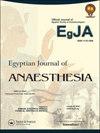Analgesic effect of sacral erector spinae, penile and caudal block after hypospadias surgery: A randomized single blind controlled trial
IF 0.5
Q3 ANESTHESIOLOGY
引用次数: 0
Abstract
ABSTRACT Background Hypospadias surgery is associated with acute postoperative pain needing long-term analgesia. Regional anaesthesia is commonly used with general anaesthesia (GA). We aim to compare sacral erector spinae plane block (ESPB) caudal and penile blocks in pain management following hypospadias surgery. Patients and methods This randomized controlled single blind trial was established on 132 pediatric cases aged from 1 to 5 years, American Society of Anesthesiologists (ASA) physical status I-II, planned for hypospadias surgery. Cases were classified into three equal groups; group C: received caudal block (CB) (1 ml/kg bupivacaine 0.25%, maximum 20 ml), group P: received penile block (0.1 ml/kg bupivacaine 0.5%, maximum 2.5 ml) and finally, group E: received ultrasound guided sacral bilateral ESPB (1 mL/kg 0.25% bupivacaine, maximum 20 ml). The blocks were done after GA induction and before the surgical incision. Results Time to 1st rescue analgesia was significantly delayed in groups C and E than group P (P < 0.001) and was insignificantly different between groups C and E. Total pethidine consumption was significantly lower in groups C and E than group P (P = 0.003, and 0.028, respectively). FLACC scores were significantly lower in groups C and E than group P at 4, 6, 8 and 12 h (p < 0.05) and were insignificantly different between groups C and E. Penile engorgement was insignificantly different among the three groups. Conclusion Both ESPB and CB had better pain control and lower opioid consumption compared to penile block, but CB is associated with incidence with penile engorgement and hypotensiveness than other techniques.尿道下裂手术后骶竖肌脊柱、阴茎和尾侧阻滞的镇痛效果:一项随机单盲对照试验
本文章由计算机程序翻译,如有差异,请以英文原文为准。
求助全文
约1分钟内获得全文
求助全文
来源期刊

Egyptian Journal of Anaesthesia
Medicine-Anesthesiology and Pain Medicine
CiteScore
0.90
自引率
0.00%
发文量
78
 求助内容:
求助内容: 应助结果提醒方式:
应助结果提醒方式:


